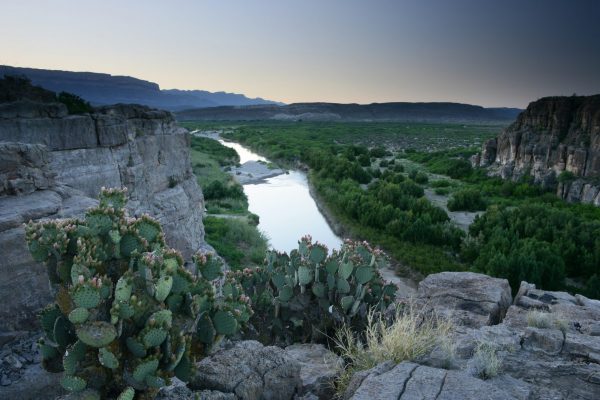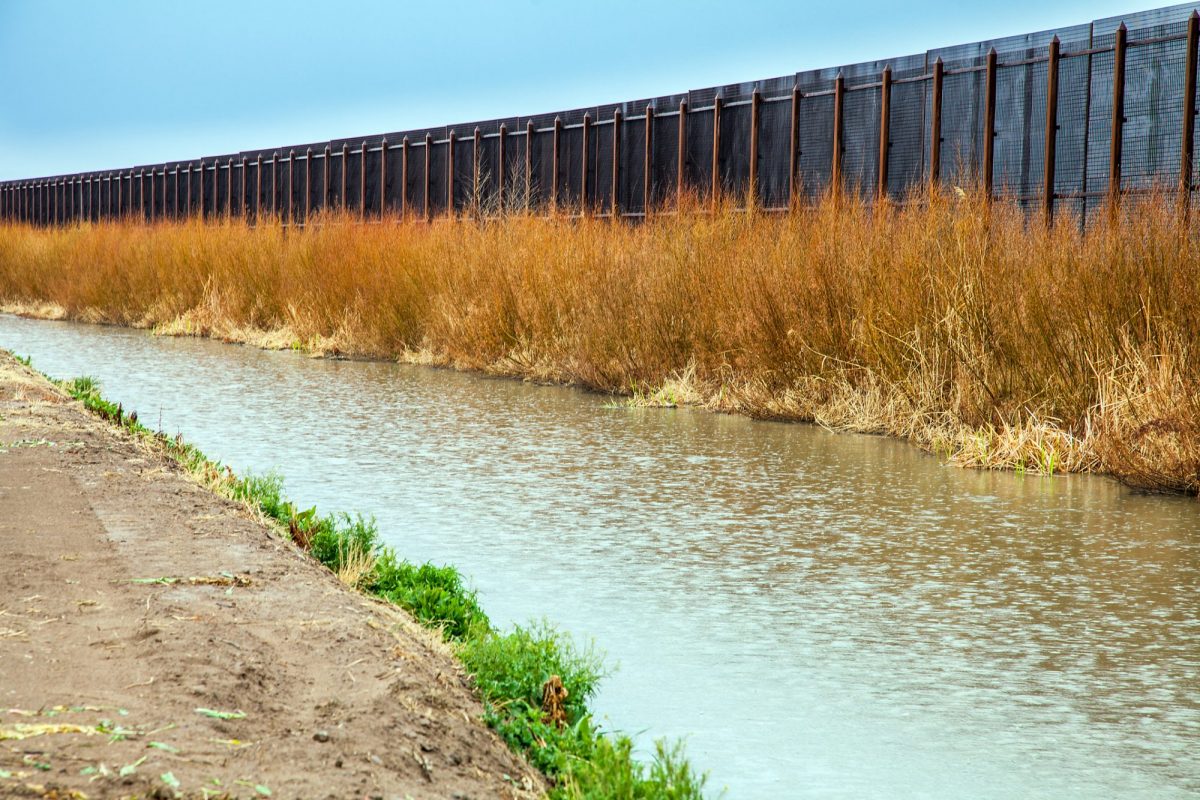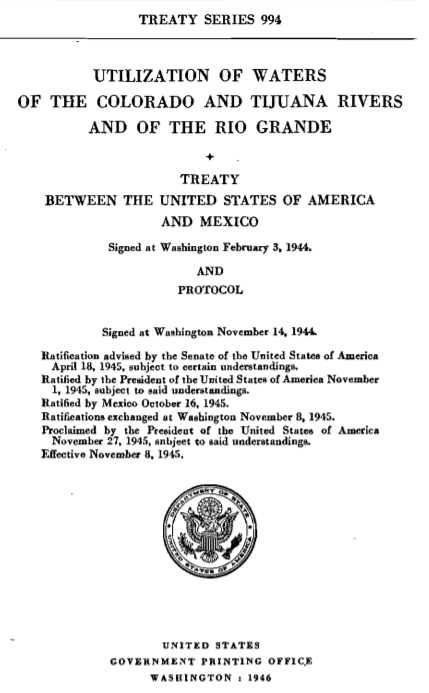
Whether the borderlines between the United States and Mexico are drawn with walls or water, there are some problems that know no boundaries.
“Before, Mexico was sort of just at the other end of the pipe,” said Colorado State University political science professor Stephen Mumme. “The U.S. did its thing and Mexico did its thing, and that was fine and dandy — until severe drought set in.”
Because both the Rio Grande and Colorado rivers' headwaters begin in the U.S. and flow across the border, both sides depend on the other for the water.
Since the 1990s, getting enough of that water has been a problem that has only been compounded over the years by a booming population and climate change to mean water scarcity on both sides.
While it may seem overwhelming, the common problem has forced the two countries to find common ground, said Mumme, who focuses on transboundary water and environmental management between the U.S. and Mexico.
A little-known treaty with big implications
In 1944, the U.S and Mexico signed an agreement on the “Utilization of Waters of the Colorado and Tijuana Rivers and of the Rio Grande.” The water treaty is probably one of the least known to the American public, Mumme said. But it’s also one of the most important.
According to the agreement, the U.S. must deliver a minimum of 1.5 million acre-feet of water to Mexico annually from the Colorado River. Alternately, Mexico must deliver at least 350,000 acre-feet of water annually from the Rio Grande.
The treaty also established the International Boundary and Water Commission to manage the Colorado and Rio Grande basins. For decades, the commission has kept things in check, but it was unprepared for the prolonged and severe water scarcity brought on by climate change.
“These droughts have really put a lot of pressure on the treaty system,” Mumme said.
What happens when the rivers run dry?
In September 2020, that pressure became a powder keg after Texas Gov. Greg Abbott demanded that Mexico fulfill its debt to the state of “a year’s worth of water from the Rio Grande.” The Mexican government eventually did repay the debt, but not without clashes with farmers who were worried about having enough water for their fields. In Chihuahua, protesters attempted to block authorities from accessing reservoirs. Following another protest, a Mexican woman was shot and killed.
The treaty wasn’t written to make concessions for times of drought and certainly didn’t consider the ramifications of climate change, Mumme said. But it was created with a certain amount of elasticity that makes him optimistic that solutions can be found. Both sides will have to make some concessions. Some steps have already begun as the U.S. and Mexico have agreed on some temporary solutions, including a pledge to revisit the treaty’s Rio Grande water rules in 2023 as well as an agreement to allow Mexico to store part of its treaty water in U.S. reservoirs upstream.
“The good news is that they’re talking to one another,” he said. “And they’re making plans and they’re sharing information at an unprecedented level.”
That doesn’t mean that negotiations won’t be difficult and filled with disagreements, Mumme added.
“These are really hard negotiations because people’s livelihoods are at stake, municipal water supplies are at stake,” he said. “This gets to some of the most basic stuff that we rely on.”
But when the stakes are this high on both sides of the border, it makes the need for cooperation a bit easier to see.

Walls and waterways
As Mumme notes in his upcoming book, Engineering Diplomacy, The Politics of Transboundary Water Resources Management Along the United States-Mexico Boundary, 1945-2015, the hydro-diplomacy concerns on the U.S./Mexico border are very specific compared to broader issues such as immigration and border security.
Unlike the water treaty, the decision to build the wall was a unilateral one, Mumme said. One made by the U.S. to keep out a problem that it deemed solely as coming from Mexico.

“It sends the message along the border that the U.S. doesn’t want to cooperate as much,” he said. “That the U.S. fears Mexico. That there are all these problems that seem to emanate out of Mexico that the United States just doesn’t want to deal with and wants to erect barriers and prevent those intrusions, and that gets in the way of a lot of important stuff that happens.”
That includes everything from commerce to cooperation. But while the wall has become a very visual symbol of a division between the two countries, there is promise.
“If you looked at these security issues over the last 20 years, you would think that the border is being hardened and stiffened and that there’s more exclusion — going both ways,” Mumme said. “But really the long-term trends are just the opposite. They’re moving toward integration, they’re moving toward collaboration and cooperation to solve a slew of mutual problems that really come into focus at the U.S./Mexico border in a lot of ways.”
Context: The U.S.–Mexico Region
"In La Paz Agreement, the United States-Mexico border region is defined as the area of land being 100 kilometers (62.5 miles) north and south of the international boundary. It stretches approximately 2000 miles from the southern tip of Texas to California. The population for this stretch of land is estimated to be approximately 15 million inhabitants. This population is expected to double by the year 2025." – Border Health Commission website
Could water become a bridge?
Like the recent drought, when the COVID-19 pandemic struck in spring of 2020 it brought another unanticipated problem to both countries. It also potentially highlighted an opportunity to work together to create solutions, Mumme said.
In a blog post in the journal Health Affairs, Mumme wrote about the need to restore the U.S./Mexican Border Health Commission.
Created in 2000, the commission was designed to help both countries deal more consistently with a wide variety of health issues in communities straddling the border, from nutrition and diabetes to infectious diseases.
The commission was defunded on the U.S. end at the beginning of President Donald Trump’s term as a cost-saving mechanism. It wasn’t seen as particularly controversial at the time, more a typical casualty of a new administration.
“It didn’t involve a lot of money, but it involved a lot of connectivity, a lot of information and building of personal relationships across the border among health professionals, so that they were in a position to react when things happened,” Mumme said.
But when the pandemic hit, some of those relationships had been lost. Officials in Mexico had worked to keep up the program on their end but the communication and coordination provided by the commission had been diminished.
“So, the big question is: Would it have made a difference to have that?” Mumme said. “Well, we’ll never know if it would, because it went away.”
U.S.-Mexico Border Health Commission: Healthy Border 2020
The five public health priorities identified by the U.S.-Mexico Border Health Commission were:
- Chronic and Degenerative Disease
- Infectious Diseases
- Maternal and Child Health
- Mental Health and Addiction
- Injury Prevention
Read more about the Healthy Border 2020 initiative at the commission's website.
But there are enough in Congress who think it could have that they are now leading efforts to restore the commission.
Like the drought, the pandemic has shed a light on why it’s important to have every possible measure in place to coordinate across the border, Mumme said. Both remind the two countries that they can cooperate on issues of common concern. And it may have been water — or more specifically, a lack of water — that opened the door.
“What we’re seeing now is more of a bi-national effort to really engage one another across the international boundary, to view these hydrological phenomena as shared problems that the two countries have to constantly be talking about, sharing information and drawing on each others’ resources to try and resolve the problems that they’re dealing with,” Mumme said. “That’s just a new game. That ups the ante along the U.S./Mexico border in a very cooperative direction that I think really spells the future.”
Navigating Borders
From water to dance, science to film, clay to gender, the liberal arts helps us navigate the borders in our lives that are physical, metaphorical, or cultural.


